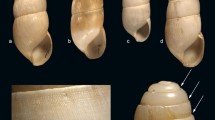Abstract
A new species of scalpellomorph barnacle belonging to the genusVulcanolepas is described from material collected at an active vent on the Pacific-Antarctic Ridge at 2212 m depth. Some specimens were attached to the glassy substratum, aphyric dacite; others were attached to peduncle and capitulum of conspecifics. The new species is related toVulcanolepas osheai from the Kermadec Ridge near New Zealand. Geographically, the nearest other neolepad population isNeolepas rapanui on the southern East Pacific Rise. The new species was found under cool conditions at near ambient temperatures, but the coating of the capitulum and stalk indicate the vent fluid was rich in heavy metals. The adult specimens were accompanied by large numbers of juveniles and recently settled individuals, suggesting either good recruitment or slow growth.
Similar content being viewed by others
References
Buckeridge, J.S. (1983): Fossil barnacles (Cirripedia: Thoracica) of New Zealand and Australia. — New Zealand Geological Survey Paleontological Bulletin,50: 1–151.
Buckeridge, J.S. (2000):Neolepas osheai sp. nov., a new deep-sea vent barnacle (Cirripedia: Pedunculata) from the Brothers Caldera, south-west Pacific Ocean. — New Zealand Journal of Marine and Freshwater Research,34: 409–418.
Jones, D.S. (1993): A newNeolepas (Cirripedia: Thoracica: Scalpellidae) from an abyssal hydrothermal vent, Southeast Pacific. — Bulletin of Marine Science,52: 937–948.
Newman, W.A. (1979): A new scalpellid (Cirripedia), a Mesozoic relic living near an abyssal hydrothermal spring. — Transactions of San Diego Society of Natural History,19: 153–167.
Newman, W.A. (1987): Evolution of cirripedes and their major groups. — Crustacean Issues,5: 3–42.
Newman, W.A. &Foster, B.A. (1983): The Rapanuian faunal district (Easter and Sala y Gómez): in search of ancient archipelagos. — Bulletin of Marine Science,33: 633–644.
Parin, N.V., Mironov, A.N. &Nesis, K.N. (1997): Biology of the Nazca and Sala y Gómez submarine ridges, an outpost of the Indo-West Pacific fauna in the eastern Pacific Ocean: composition and distribution of the fauna, its communities and history. — Advanced Marine Biology,32: 145–242.
Southward, A.J. &Jones, D. (2003): A revision of stalked barnacles (Cirripedia: Thoracica: Scalpellomorpha: Eolepadidae: Neolepadinae) associated with hydrothermalism, including a description of a new genus and species from a volcanic seamount off Papua-New Guinea. — Senckenbergiana maritima,32: 77–93.
Southward, A.J. &Newman, W.A. (1998): Ectosymbiosis between filamentous sulphur bacteria and a stalked barnacle (Scalpellomorpha, Neolepadinae) from the Lau Back Arc Basin, Tonga. — Cahier Biologie Marine,39: 259–262.
Southward, A.J., Newman, W.A., Tunnicliffe, V., Scheirer, D. &Johnson, K. (1997): Biological indicators confirm hydrothermal venting on the Southeast Indian Ridge. — BRIDGE Newsletter,12: 35–39.
Stecher, J., Türkay, M. &Borowski, C. (2002): Faunal assemblages on the Pacific-Antarctic Ridge near the Foundation Seamount Chain (37°30′ S, 110°30′ W). — Cahier Biologie Marine,43: 271–274.
Stoffers, P., Worthington, T., Hekinian, R., Petersen, S., Hannington, M., Türkay, M., Ackermand, D., Borowski, C., Dankert, S., Fretzdorff, S., Haase, K., Hoppe, A., Jonasson, I., Kuhn, T., Lancaster, R., Monecke, T., Renno, A., Stecher, J. &Weierhäuser, L. (2002): Widespread silicic volcanism and hydrothermal activity on the northern Pacific-Antarctic Ridge. — InterRidge News,11 (1): 30–32.
Tunnicliffe, V. &Southward, A.J. (2004): Growth and breeding of a primitive stalked barnacle,Leucolepas longa (Cirripedia: Scallpellomorpha: Eolepadidae: Neolepadidae) inhabiting a volcanic seamount off Papua New Guinea. — Journal of Marine Biology Association of U.K.,84: 121–132.
Van Dover, C.L. (2000): The ecology of deep-sea hydrothermal vents: 424 pp.; Princeton (University Press).
Yamaguchi, T., Newman, W.A. &Hashimoto, J. (2004): A cold seep barnacle (Cirripedia: Neolepadinae) from Japan and the age of the vent/seep fauna. — Journal of Marine Biology Association of U.K.,84: 111–120.
Author information
Authors and Affiliations
Corresponding author
Rights and permissions
About this article
Cite this article
Southward, A.J. Systematics and ecology of a new species of stalked barnacle (Cirripedia: Thoracica: Scalpellomorpha: Eolepadidae: Neolepadini) from the Pacific-Antarctic Ridge at 38° S. Senckenbergiana maritima 35, 147–156 (2005). https://doi.org/10.1007/BF03043683
Received:
Accepted:
Issue Date:
DOI: https://doi.org/10.1007/BF03043683




